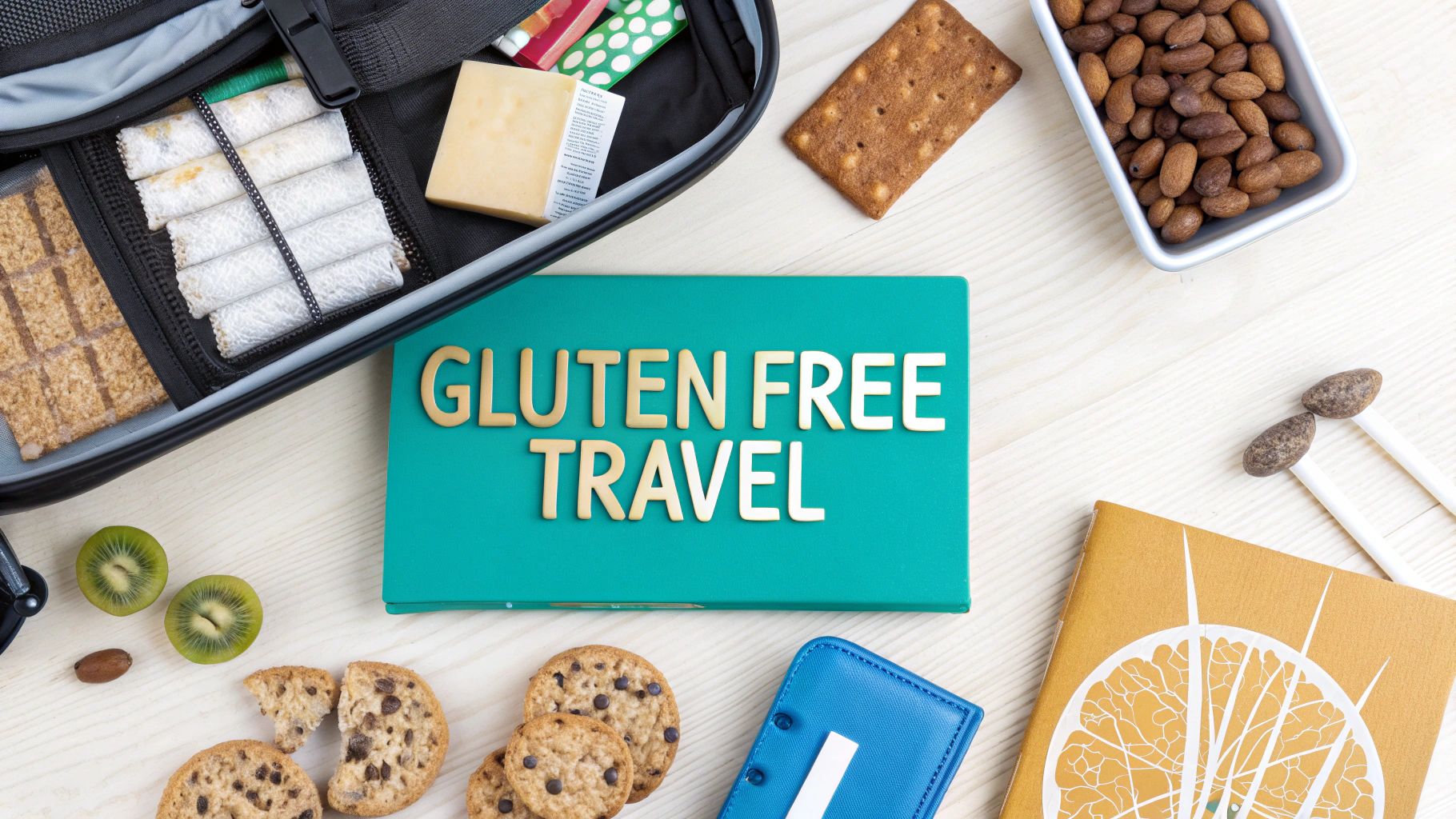

· By Annemarie
Your Guide to Gluten Free Travel Snacks
When it comes to the best gluten free travel snacks, you want things that are shelf-stable, packed with nutrients, and super easy to throw in a bag. Think individually wrapped protein bars, certified gluten-free trail mixes, dried fruit, and even single-serving wellness boosts like Upside Hangover Sticks for hydration and getting back on your feet.
Why Gluten Free Travel Snacks Are Essential
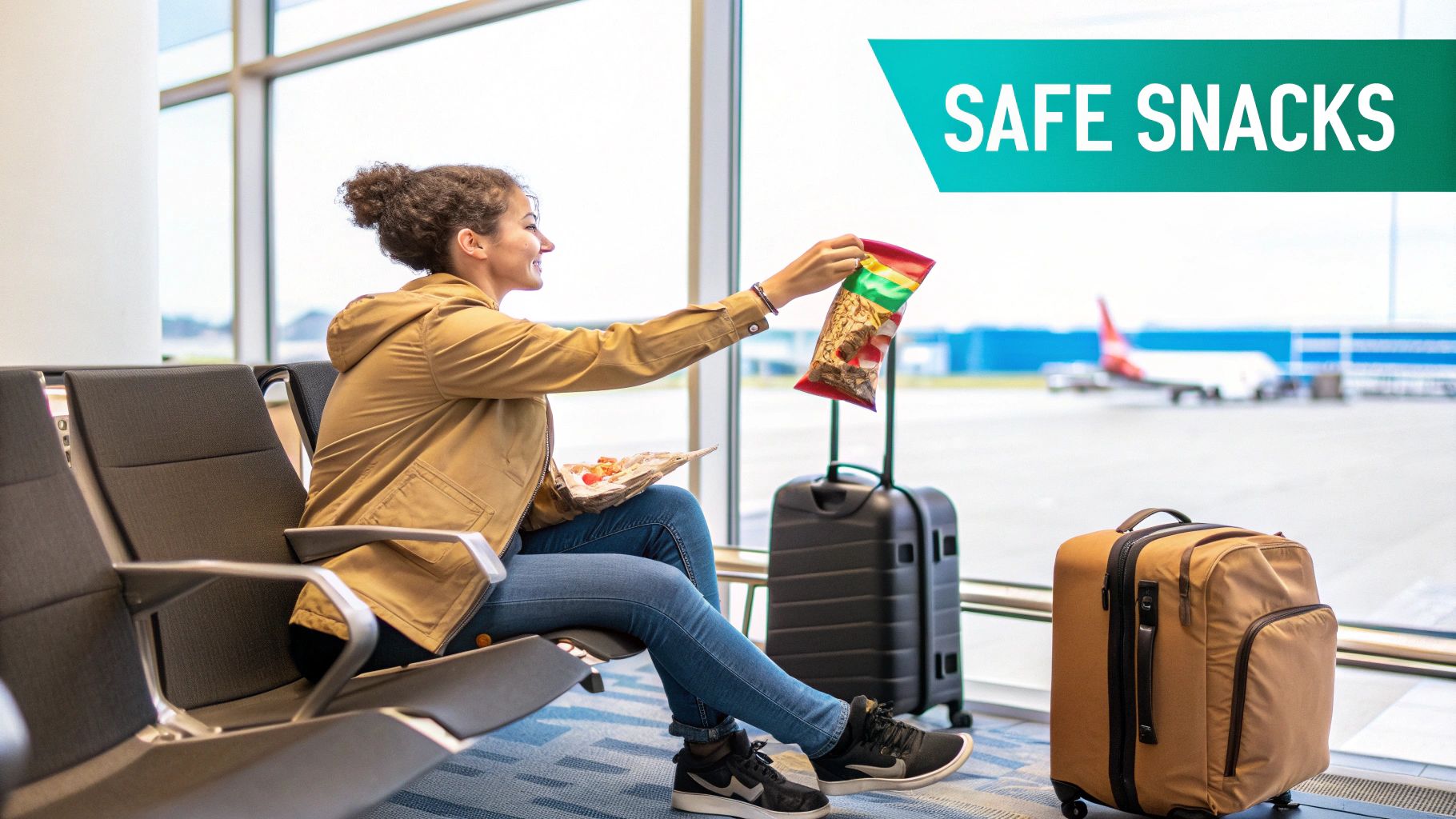
Traveling with dietary restrictions can feel like trying to find your way through a minefield. The right snacks, though? They can turn a stressful experience into a smooth one. A well-stocked snack bag isn't just a nice-to-have; it's your most important travel buddy.
For anyone who has to avoid gluten, being spontaneous with food often takes a backseat to serious planning. Airports, gas stations, and random cafes are a triple threat: limited options, crazy high prices, and the sneaky risk of cross-contamination. Trying to find safe food on the fly can quickly lead to hunger, frustration, and a whole lot of unnecessary stress.
Your Personal Insurance Policy
It helps to think of your gluten free travel snacks as an insurance policy for your health. Having your own stash of trusted foods means you always have a safe option, no matter where your trip takes you. That simple bit of prep brings so much peace of mind.
This proactive approach means you can:
- Keep Your Energy Up: No more energy crashes from skipping meals or grabbing the first sugary, empty-calorie thing you see.
- Avoid Getting Glutened: You totally eliminate the risk of cross-contamination from shared kitchens or staff who just don't get it.
- Actually Enjoy Your Trip: You get to focus on the adventure instead of constantly stressing about where your next safe meal is coming from.
A well-packed snack bag is the key to a stress-free trip. It lets you handle flight delays, weird food deserts, and long stretches between meals without messing with your health or your fun.
Navigating the Challenges of Travel
Smart packing is about more than just not being hungry—it's about staying in control of your diet when everything else feels unpredictable. Things like flight delays, remote destinations with no grocery stores, or language barriers can make finding safe food a nightmare.
Your snack stash is your buffer against all that chaos. Sure, the world is getting more health-conscious, but you can never count on finding what you need. The demand for gluten-free products is blowing up—the global market was estimated at USD 8.20 billion in 2025 and is projected to hit USD 13.70 billion by 2034. That's pushed many airlines and airports to offer more, but it's never a guarantee.
At the end of the day, coming prepared with your own snacks is the best way to take care of yourself. Our guide on how to stay healthy while traveling has even more tips for keeping your wellness on track when you're on the road.
Choosing the Best Store-Bought Gluten Free Snacks
Let's be real—sometimes meal prep before a trip just isn't going to happen. That's where hitting the grocery store for some reliable, grab-and-go options can be a total lifesaver. Think of the snack aisle as your mission control for putting together a solid gluten-free travel kit. A little strategy here goes a long way in making sure you've got the right fuel for every leg of your journey.
The trick is to look past just the "gluten-free" label. A truly great travel snack stash is all about balance. You'll want a mix of protein to keep you full and energized, some quick carbs for an instant pick-me-up, and of course, something with a satisfying crunch for those moments you just need a snack.
Mastering the Art of Label Reading
Before you even start thinking about what kind of snacks to get, you have to become a bit of a gluten-free detective. Reading labels is your absolute first line of defense against getting accidentally glutened. Not all "gluten-free" claims are the same, and sneaky gluten sources can pop up in the most unexpected places.
Here’s what to keep an eye out for to make sure your snacks are genuinely safe:
- Certified Gluten-Free Seals: Your best bet is to look for official seals from trusted groups like the Gluten-Free Certification Organization (GFCO). This little symbol is a guarantee that the product has 10 ppm of gluten or less—which is even stricter than the FDA's standard of under 20 ppm.
- "Contains Wheat" Allergen Statement: The law requires major allergens like wheat to be clearly listed. This is a super quick way to rule out a lot of products. Just remember, something can be wheat-free but still have gluten from barley or rye.
- Hidden Gluten Ingredients: Get a little skeptical with vague terms on the ingredient list. Watch out for things like malt, brewer's yeast, and even certain starches or natural flavors that could come from gluten-containing grains.
This infographic lays out a simple way to think about building a balanced gluten-free snack pack for your next trip.
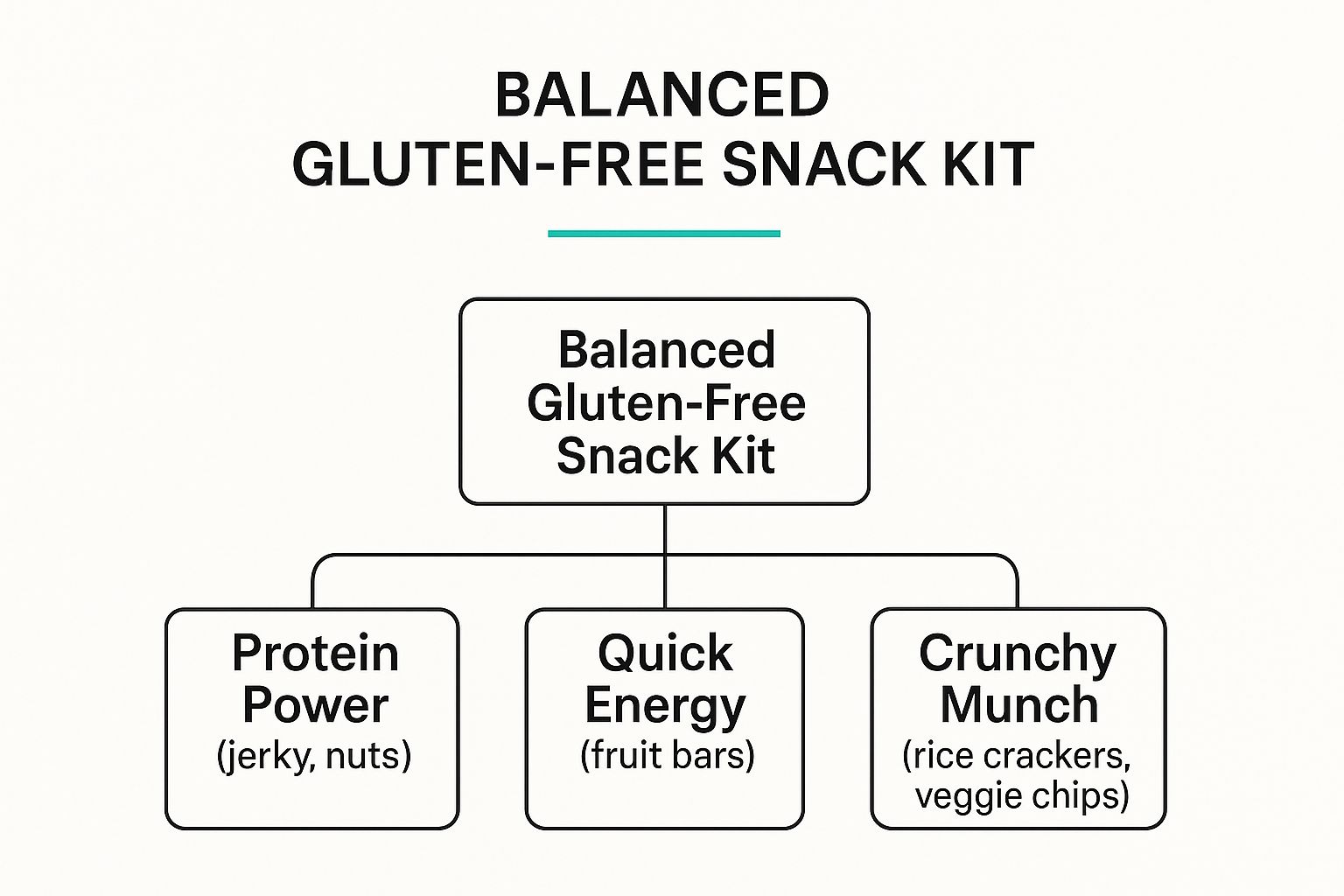
By breaking down your choices into categories, you can make sure you’ve got all your bases covered—from lasting energy to a quick boost and that all-important crunch.
Building Your Balanced Snack Arsenal
Once you know how to spot the safe stuff, you can get to the fun part: building your perfect mix of gluten-free travel snacks. You'll want a variety that can handle anything from a long flight to a full day of exploring. Luckily, the market for these products has exploded, making it easier than ever to find awesome, high-quality options.
The gluten-free prepared food market has seen some serious growth, on track to hit $7004.1 million by 2025. This is happening because more people are getting diagnosed with celiac disease or just choosing to go gluten-free. It's made convenient, healthy travel snacks a top priority, and online stores have made them incredibly easy to find.
A great travel snack kit isn't just a random collection of food; it's a hand-picked selection designed to keep you energized, satisfied, and feeling good, no matter what your travel day throws at you.
Here’s a quick guide to some of the best categories to stock up on.
Top Store-Bought Gluten Free Snack Categories
| Snack Category | Examples | Key Travel Benefit | What to Look For |
|---|---|---|---|
| Protein & Energy Bars | RXBAR, Larabar, Kind Bars | Sustained energy, satisfying | Simple ingredients, low added sugar |
| Nuts, Seeds & Trail Mix | Almonds, walnuts, sunflower seeds | Healthy fats, long-lasting fuel | Unsalted or lightly salted, no sugary coatings |
| Dried Fruit & Fruit Snacks | Dried mangoes, apple chips | Quick natural sugar boost | No added sulfates or preservatives |
| Crunchy Snacks | Rice crackers, corn chips, veggie straws | Satisfies cravings, good for dipping | Made from corn, rice, or legumes |
| Meat Snacks | Beef jerky, turkey sticks | High protein, very filling | Low sodium, nitrate-free |
Stocking a few items from each of these categories pretty much guarantees you'll have the perfect snack for any situation.
Don't Forget Wellness and Hydration
Beyond the usual food, think about tossing some single-serving wellness supplements into your bag. Long flights, weird schedules, and late nights can really do a number on your body, especially when it comes to staying hydrated and feeling your best.
Single-serving sticks are perfect for travel—they’re light, mess-free, and take up almost no space. Products like Upside Hangover Sticks aren't just for the morning after; they're great as a general wellness boost. They can help you stay hydrated and give your body supportive, natural ingredients to feel refreshed and ready to go. You can explore the thoughtfully selected, high-quality ingredients in Upside to see how they fit into your travel wellness goals. Adding a wellness stick to your daily routine on the road is a smart move to stay on top of your game.
Easy and Delicious DIY Gluten Free Snack Recipes
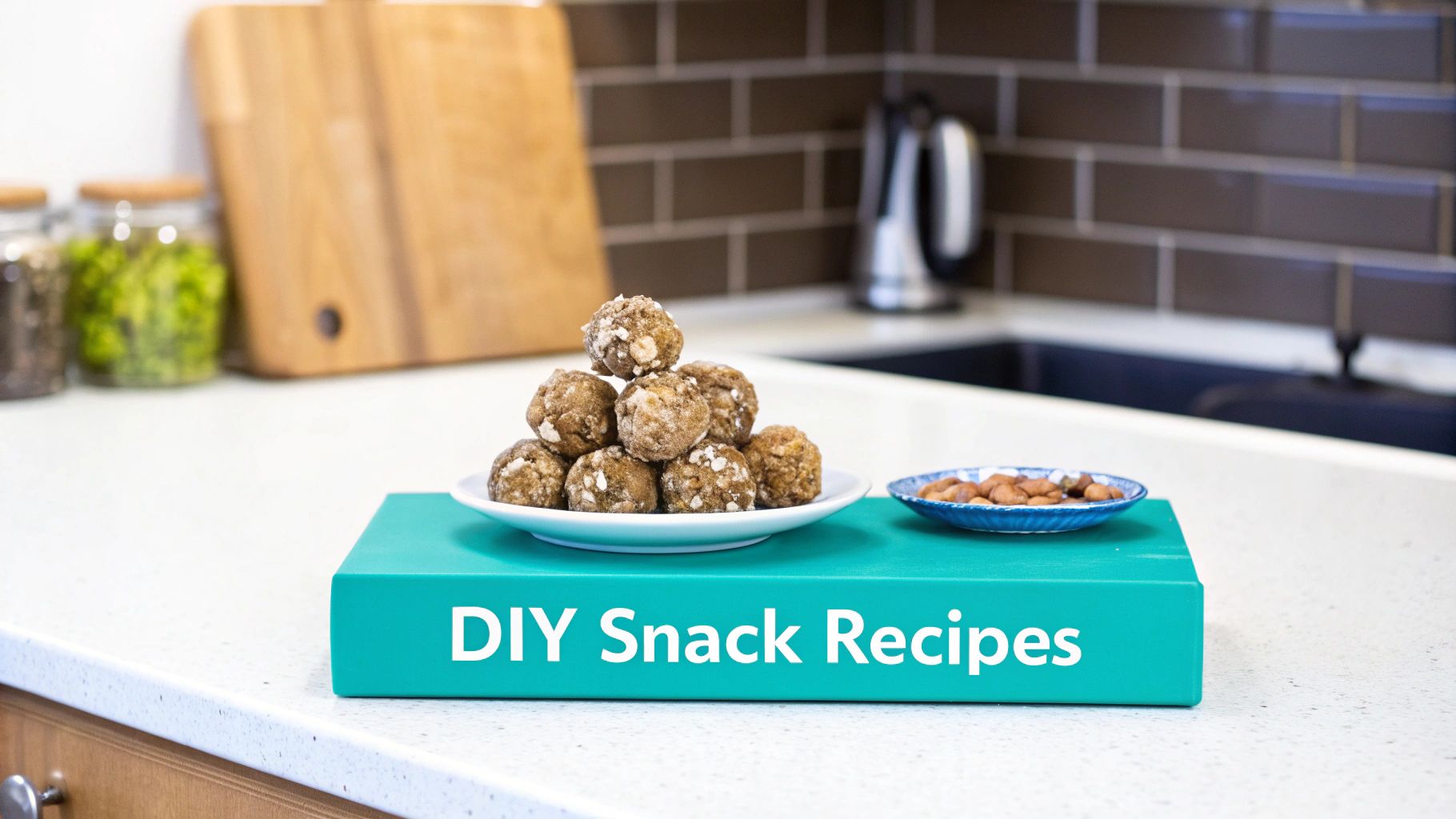
While grabbing a pre-packaged snack is convenient, there’s a special kind of peace of mind that comes from making your own. When you prep your own gluten-free travel snacks, you’re in the driver’s seat. You know every single ingredient that goes in, which means zero guesswork about hidden gluten or cross-contamination.
Making snacks at home also lets you get creative and adjust for your specific tastes or any other dietary needs. Plus, it’s usually way easier on your wallet. The secret is to stick with recipes that are simple, don't require a ton of ingredients, and are sturdy enough to survive a trip in your bag without needing a fridge.
No-Bake Energy Bites The Ultimate Portable Fuel
If there’s one superstar of DIY travel snacks, it’s the no-bake energy bite. They’re ridiculously easy to throw together, loaded with nutrients for real, sustained energy, and you can customize them in a million different ways. You just need a base, something to hold it all together, and your favorite extras.
Here’s a can’t-mess-it-up recipe to get you rolling:
- Combine the Base: In a bowl, mix 1 cup of certified gluten-free rolled oats with 1/2 cup of ground flaxseed. This combo gives you a solid, fiber-packed foundation.
- Add the Binder: Stir in 1/2 cup of your favorite nut or seed butter (almond or sunflower seed butter are great) and 1/3 cup of honey or maple syrup. This is the tasty glue that holds it all together.
- Include Mix-Ins: Gently fold in 1/2 cup of whatever you’re craving. Think dark chocolate chips, shredded coconut, or dried cranberries.
- Chill and Roll: Pop the mixture in the fridge for about 30 minutes to let it firm up. Then, just roll it into perfect, bite-sized balls.
Toss them in a hard-sided container so they don't get squished. They’re the perfect little fuel-up for a long day of travel.
By preparing your own snacks, you're not just packing food; you're packing peace of mind. You know exactly what’s in every bite, ensuring your journey is delicious, safe, and worry-free.
Crafting Your Own Custom Trail Mix
Forget those store-bought trail mixes that are half sugary candy and full of potential cross-contaminants. Making your own is so simple and lets you build a blend that’s perfectly tuned to your energy needs and what you actually like to eat.
Think of it like creating your own personal power-up mix. The goal is to get a good balance of protein, healthy fats, and natural sugars for both a quick burst of energy and some that will last you a while.
Pro-Tips for a Perfect Blend:
- Start with a Nut and Seed Base: Almonds, walnuts, pecans, pumpkin seeds, and sunflower seeds are all fantastic for a protein-rich foundation. If you need a nut-free option, just go all-in on the seeds!
- Add Dried Fruit for Energy: Toss in some unsulfured dried fruits like apricots, mangoes, or raisins for that natural carb boost.
- Introduce Some Crunch: For a satisfying texture, try adding roasted chickpeas, gluten-free pretzels, or some puffed rice cereal.
- A Touch of Sweetness: If you want, add a small handful of dark chocolate chips or unsweetened coconut flakes.
Mixing and matching is half the fun! A lot of these ingredients, especially nuts and seeds, are also known for their wellness perks. For more ideas on foods that support your body, check out our guide on this anti-inflammatory foods list.
Homemade Fruit Leather A Healthy Treat
Fruit leather is the perfect way to satisfy that sweet tooth without reaching for processed candy. It’s basically just pureed fruit that’s been dehydrated, making it super lightweight, mess-free, and ideal for travel.
Easy Oven Method:
- Puree Your Fruit: Blend 3 cups of your favorite fruit—strawberries, mangoes, and apples work great—until it's totally smooth. A tablespoon of honey or lemon juice can add a nice touch of flavor.
- Spread Thinly: Pour the puree onto a baking sheet lined with parchment paper or a silicone mat. Spread it out into a very thin, even layer.
- Dehydrate Slowly: Bake at your oven’s lowest setting (usually around 170°F or 77°C) for 4-6 hours. You'll know it's done when the center isn't tacky anymore.
- Cut and Store: Once it’s cool, use scissors to cut the fruit leather (still on the parchment paper) into strips. Roll them up for an easy grab-and-go snack.
Smart Packing Strategies for Your Gluten Free Snacks
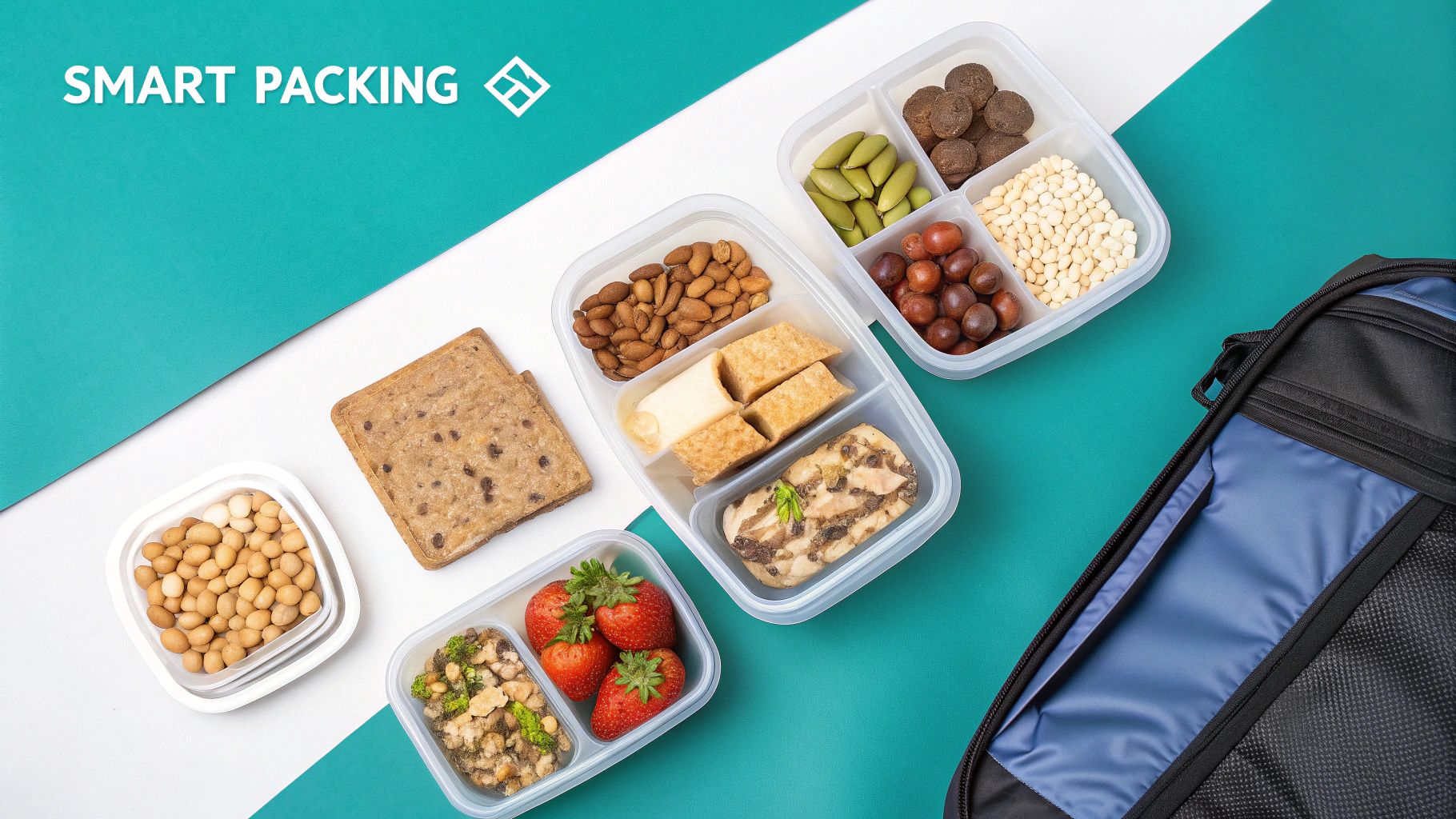
Alright, you've picked out your perfect gluten-free travel snacks. Now comes the real challenge: getting them to your destination without turning them into a bag of crumbs. Packing isn't just about cramming things into a suitcase; it’s an art form meant to protect your food from getting crushed, leaking, or spoiling.
Think about it. A poorly packed bag can quickly lead to a tragedy of crumbled crackers and bruised fruit. The right containers and a little bit of planning are your best friends here. It's the difference between a satisfying, stress-free snack and a disappointing mess.
Choosing the Right Containers for the Job
The containers you choose can make or break your snacking experience. You need something that can shield fragile stuff while keeping everything else fresh and easy to grab. Trust me, investing in a small collection of travel-friendly containers is a game-changer for anyone who travels often.
Here are a few options to get your packing kit started:
- Hard-Sided Containers: These are a must-have for anything that crunches. Use them for your gluten-free crackers, rice cakes, and cookies. They act like a protective shell against the chaos of a packed suitcase.
- Reusable Silicone Bags: I love these for trail mix, nuts, and dried fruit. They’re super durable, flexible, and way better for the planet. Plus, they seal tightly to stop spills and are a breeze to wash and reuse.
- Small, Leak-Proof Jars: Bringing nut butter or hummus? These little guys are essential, especially if you're flying. Just make sure they’re under 3.4 oz for your carry-on to avoid any drama at security.
When you match the snack to the right container, you create a system that keeps everything safe and sound. It’s a simple step that makes a huge difference.
Portioning and Strategic Placement
Packing is also about making your life easier on the road. You don’t want to be digging through your entire bag just to find one little energy bar. Portioning out your snacks into single servings before you leave makes them easy to grab when hunger strikes. It also helps you pace yourself so you don't run out on day one.
A good rule of thumb is to divide your snacks between your carry-on and checked luggage. Think about what you'll need right away versus what can wait.
Carry-On vs. Checked Bag Strategy:
| Luggage Type | Recommended Snacks | Rationale |
|---|---|---|
| Carry-On Bag | A day's worth of snacks, energy bars, anything fragile. | Keeps your must-haves within reach for flight delays or as soon as you land. You can also play bodyguard for your more delicate items. |
| Checked Bag | Bulk supplies, extra non-perishables, sturdier snacks. | This frees up precious space in your carry-on and gives you a solid back-stock for the rest of your trip. |
This two-bag approach means you're ready for anything, with immediate fuel and plenty of reserves for the whole adventure.
"A well-packed snack bag is your pre-flight checklist for a hassle-free journey. It empowers you to handle travel's unpredictability with confidence, knowing you have safe and delicious options within reach."
Navigating Airport Security with Food
Let's be real, airport security can be a major source of travel anxiety. But here's the good news: most solid food items are totally fine to bring in your carry-on. The Transportation Security Administration (TSA) has pretty clear guidelines you can check out before you go.
Solid foods like bars, nuts, crackers, and dried fruit usually get through without a problem. It’s the semi-liquids and gels—like yogurt, nut butters, and hummus—that you need to watch. They fall under the 3-1-1 rule: they must be in containers of 3.4 ounces (100 ml) or less, and all of them have to fit into one clear, quart-sized bag.
A little tip? Just let the security officers know you have food in your bag. It can help speed things up. With a tiny bit of prep, you'll glide right through.
Finding Safe Gluten-Free Food at Your Destination
Sooner or later, even the most perfectly packed stash of gluten-free travel snacks is going to run out. For many of us, this is where that familiar travel anxiety starts to creep in. But it doesn’t have to.
With a little help from modern tech and some smart prep work, you can turn the challenge of finding safe food into just another fun part of the adventure. Your smartphone is probably your best friend here. A bit of research before you even pack your bags can build a solid safety net, so you always know where to turn when you get hungry.
Using Technology to Find Safe Eats
Figuring out where to eat gluten-free used to feel like a wild goose chase. Now, it's more like a guided tour, thanks to some killer apps and websites. These tools are powered by huge communities of gluten-free folks who've already done the legwork, vetting restaurants, cafes, and grocery stores for us.
Before your next trip, get familiar with these lifesavers:
- Dedicated Apps: "Find Me Gluten Free" is non-negotiable. It’s packed with user reviews from all over the world, often giving you the inside scoop on which menu items are safe and how careful the kitchen is with cross-contamination.
- Travel Blogs and Forums: A quick Google search for "gluten-free [your destination]" is a goldmine. You'll find tons of posts from travelers who've been there, done that, and documented all the hidden gems you won’t find on mainstream sites.
- Online Grocery Store Maps: Just use Google Maps to scout out grocery stores near where you’re staying. Most big chains now have dedicated gluten-free aisles, perfect for restocking your snack bag or grabbing stuff for a simple, safe meal.
Doing this homework pays off, big time. It's especially true in places like North America, which is leading the global gluten-free market. In 2024, consumer demand for health-conscious and gluten-free foods in the U.S. was sky-high, which means you're much more likely to find familiar brands and safe options on the shelves. You can check out more trends on the growing gluten-free food market over at Renub Research.
How to Actually Communicate Your Needs
Okay, so you've found a few promising spots. Now comes the critical part: making sure they actually understand what you need. A language barrier or just a lack of awareness about celiac disease can be a real problem. Never assume a server or chef knows what "gluten-free" really means.
One of the smartest things you can do is carry a gluten-free translation card. These little cards are amazing—they explain your dietary needs, list ingredients you can't have, and stress the importance of avoiding cross-contamination, all in the local language.
Seriously, these cards are way more effective than awkwardly trying to use a translation app at the table. They show how serious your medical needs are and give the kitchen staff clear instructions on how to prepare your food safely. You can find printable cards online for dozens of languages. They’re a must-have.
Reading Labels and Finding Local Gems
Wandering through a local supermarket can be an adventure in itself. When you're trying to read labels in another language, look for the allergen information—in many places, like the European Union, major allergens like wheat have to be printed in bold. Also, keep an eye out for the universally recognized "crossed grain" symbol, which certifies a product as gluten-free.
Beyond the packaged stuff, look for local dishes that are naturally gluten-free. This is the best way to experience the culture through its food without taking huge risks.
Naturally Gluten-Free Dishes to Look For:
- Grilled Meats and Fish: So many cuisines feature simple grilled proteins with herbs, lemon, and olive oil. It's a classic for a reason and usually a safe bet.
- Rice-Based Dishes: Think Spanish paella or Indian biryani. Just double-check that they aren't using any gluten-filled broths or soy sauce.
- Fresh Salads and Vegetables: You can find a simple salad or steamed veggies pretty much anywhere. It's a fresh, reliable backup plan.
- Corn-Based Foods: If you're in Latin America, you're in luck. Corn tortillas, arepas, and tamales are often naturally gluten-free and absolutely delicious.
By sticking to these kinds of foods and communicating clearly, you can navigate almost any food scene with confidence. It completely changes the game, turning a potential source of stress into a delicious part of your trip.
Got Questions About Gluten-Free Travel Snacks? We've Got Answers.
Figuring out the world of gluten-free travel snacks can feel like a headache waiting to happen. From airport security to keeping things fresh on a long trip, getting a few clear answers can make all the difference. We’ve got you covered with straightforward solutions to the most common questions.
A little prep work goes a long way. Knowing the rules beforehand lets you focus on the fun stuff, not on whether your snacks will make it through TSA.
So, Can I Bring My Own Homemade Gluten-Free Snacks On a Plane?
You bet! Solid foods are totally fine. Things like your homemade energy bites, that special trail mix recipe, and gluten-free cookies are good to go in both your carry-on and checked bags. They’re some of the best gluten-free travel snacks you can have on hand.
The only real catch is anything semi-liquid. If you're packing nut butters, applesauce, or yogurt, they have to follow the 3.4 oz (100 ml) liquid rule for carry-ons. Just toss them in a clear, sealed container, and you’ll sail right through security.
What Are the Best Non-Perishable Snacks for Super Long Trips?
When you’re on the road for a while and don't have a fridge, you need snacks that can hang in there. The name of the game is shelf-stable and packed with energy.
A few of our go-to's include:
- Certified gluten-free jerky for a serious protein kick.
- Dried fruit, nuts, and seeds for that perfect mix of healthy fats and natural sugars.
- Roasted chickpeas or fava beans when you need something crunchy and savory.
- Individually wrapped protein or fruit bars because you just can’t beat the convenience.
These guys are tough, full of nutrients, and perfect for everything from a 12-hour flight to a week-long trek.
How Do I Actually Avoid Cross-Contamination With My Snacks?
This is a big one. Your best bet is to stick with snacks that are individually wrapped and come from a certified gluten-free facility. That little seal is your guarantee that they weren't made on equipment that handles gluten.
If you’re whipping up snacks at home, give all your cooking surfaces, utensils, and containers a good scrub before you even think about starting. And when you're out and about, steer clear of those bulk bins at the grocery store—you never know if the scoop for the gluten-free granola was just used in the wheat bran.
One of the biggest mistakes people make is just assuming a food is safe. Don't be shy about asking questions! A simple translation card that explains celiac disease can be a total game-changer in other countries, preventing those "oh, but it doesn't have wheat flour" misunderstandings.
Are There Any Apps That Can Help Me Find Gluten-Free Food on the Go?
Absolutely. Your phone can be your best friend here. Apps like "Find Me Gluten Free" are a must-have, with a huge database of restaurants and bakeries all over the world, complete with real reviews from other gluten-free eaters.
Don't forget about travel bloggers, either. A quick search can pull up incredibly detailed, city-specific guides from people who have already done all the legwork. Using these tools before you even leave home can save you so much stress by helping you map out safe (and delicious) places to eat.
And for a wellness boost that’s just as easy to pack as your snacks, grab some Upside Hangover Sticks. They're certified gluten-free, travel-friendly, and perfect for helping you stay hydrated and feel amazing on your trip. See how they can fit into your travel routine at https://enjoyupside.com.
#upside #enjoyupside #upsidejelly #livemore #hangovercure #hangoverprevention #fighthangovers #preventhangovers #HangoverRelief #MorningAfter #PartySmarter #HydrationStation #WellnessVibes #RecoverFaster #NoMoreHangovers #HealthyParty #HangoverHacks #FeelGoodMorning #NightlifeEssentials #HangoverFree #SupplementGoals #PostPartyPrep #GoodVibesOnly #HealthAndParty #HangoverHelper #UpsideToPartying
